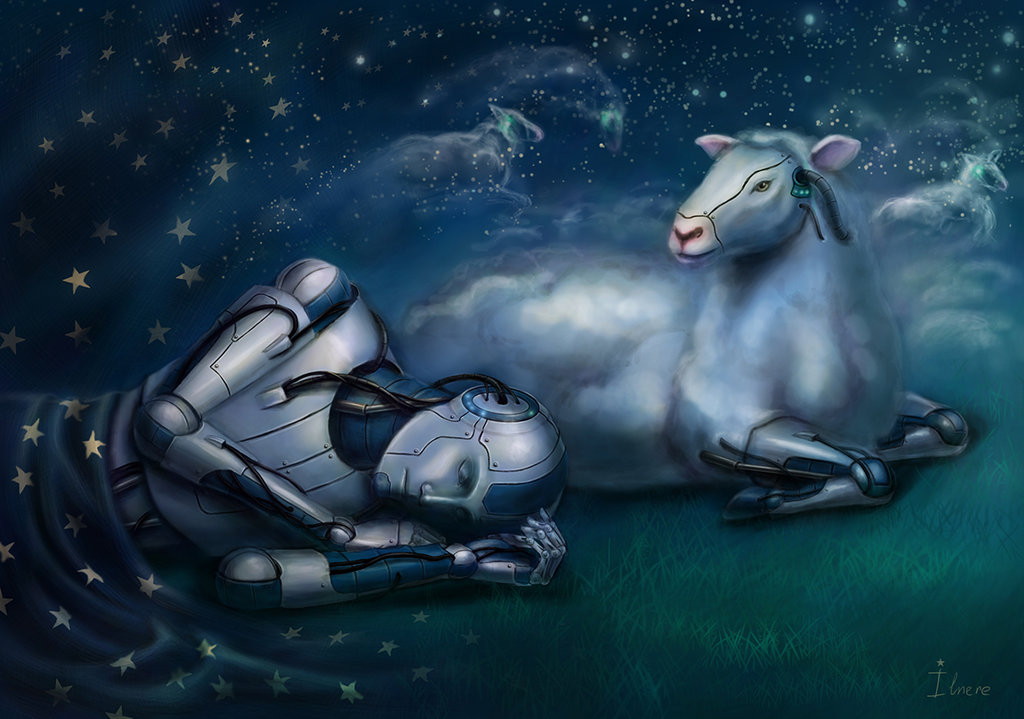
Posted on April 29, 2017
Do you dream of…an empathy leader?
Rick Deckard went to sleep. As a bounty hunter, his assignment was to eliminate androids. Through the ‘Voigt-Kampff test’ his draining job was to see if and how androids react in social situations. Then to find out if they are humans or replicants. Firmly you assume that androids lack of empathy. These replicants were created to be exploited. Before to get ready to go after the androids, Rick wakes up and the “mood organ” can handle the feelings depending on the settings. The plot and actually what happens to Rick triggers questions about identity and the importance of relating to others through empathy.
The above scenario is a science fiction story written by Philip K. Dick some 50 years ago, but now look at your own surroundings as you are in an organization – regardless if it is a big corporate or a small start-up: the “mood organ” is your device screen. The use of technology and how we take for granted its centralized access to info and feelings is the setting of this “mood organ”. All of sudden we might question who is really a human and who is an android.
How does it sound? If surreal…How do we consider the value of empathy and leadership? Do we need a… bounty hunter in the real world? We are close to using driverless cars, to delivering goods with drones, we start chewing the fascinating ‘sharing economy’ impact but if we turn the page we read about Susan Fowler about Uber culture and its massive gap in gender inequality in 2017.
If inequality keeps roaring we must discuss how we imagine the world differently and find a way to share this vision. How? Let’s update our views and accustom ourselves to seeing ideas to become a slow unstoppable train to change our society for the best ( Human-Centred Design, Universal Basic Income, Blockchain).
We all are, have been or will be Rick Deckard (or the female alter ego), going back feeling baffled, exhausted or with disbelief and looking for an empathy box. Yet we can make a difference by creating trust, self-esteem and empathy with real world interaction and listening. Social media are tools to use sparingly to take inspiration, not addiction.
We must flip the connection with why we do what we do. The following is a example, how we need to build solid bridges to create an impact. The rules of the game are simple as much as daring, it will engage yourself for life. Adrian Piper frames this concept with a clear message with The Probable Trust Registry:
I always mean what I say
I always do what I say I am going to do
I will always be too expansive to buy
These statements are as simple as inspiring. They frame the spine of our social economic development as a collective and as individuals. In our relationship with ideas, projects, culture and leadership we need principles to build up creativity, trust and empathy. Eventually they won’t give us the answer about the future but they will make us familiar with experimentation and learning as a life-long habit.
You can be an empathy leader.
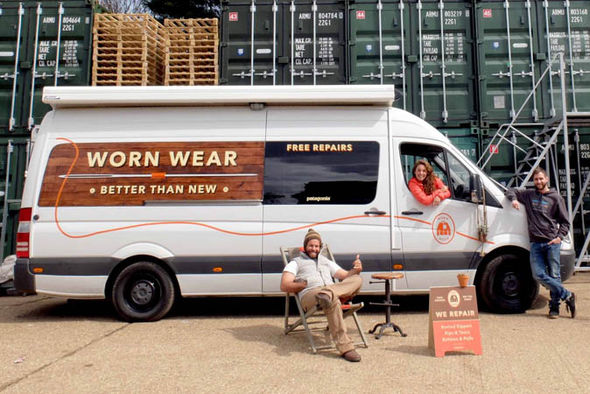
Updated on February 3, 2017
The next wave in Innovation is to design new Circular Economy challenges
Circular Economy is increasingly part of the Innovation opportunities to design a new business landscape with a customer-centric focus. What is Circular Economy? It means reusing, repairing, re-manufacturing and re-marketing goods and components in an industrial context. These smallest loops of economy can generate the biggest financial benefit as well as the lowest price for the consumer or the highest profit margin for the manufacturer. Finally, considering the sustainability impact, the Circular Economy aims to optimize three factors: economic, ecological and social.
A successful example is Patagonia that designs clothing products in the U.S., outsources manufacturing to external suppliers in emerging markets with cheaper labor, and ships finished goods to developed markets for sale. The company screens suppliers through a “4-fold approach”: ethical sourcing, product quality, social responsibility, and environmental compliance. “All 4 areas have equal veto power” says Patagonia. The business model’s credibility (adherence to ethical and environmental business practices) rests on adherence to these commitments within its operating model. Patagonia is one, maybe more the one, step ahead in re-thinking the role and the impact of Corporate Social Responsibility.
Social responsibility (environmental and labor initiatives, primarily) has become a greater competitive advantage for Patagonia than even product quality. Environmental commitments include sustainably grazed wool, 100% organic cotton, 100% traceable down, environmental audits of factories, and waste management technology.
The environmental responsibility is the very heart of the Patagonia business vision and this is why deservedly they received the Accenture Strategy Award for Circular Economy Multinational at the World Economic Forum in Davos, Switzerland.
Puma is another example with its new Financing Program to Reward Suppliers for Sustainability Performance. It started last September.
Puma joined other few companies as the first time such investment on innovation has been made in Sport industry to generate a return. As Puma says “…a great example of cross-functional internal collaboration of PUMA’s finance functions and operations, which underlines our ambition to implement fast and efficient processes.” The systematic approach and the inspiration underpin an organizational cultural change scenario which is very challenging and therefore could unleash innovative practices in the business design landscape.
Updated on July 27, 2016
User-centred design can be a driver in organizations: SoundCloud report
My purpose is to explore the opportunity to embed the Human-Centred-Design methodologies in business models culture. The report below suggests to equip the organizations with the understanding of customer needs as a real competitive advantage. Deloitte just released the 2016 Global Human Capital Trends report “The new organization: Different by design”.
User Experience (UX) methods were developed largely to evaluate product usability and are primarily applied to web usability contexts. Other methods, such as co-design and human centered design, also provide approaches to facilitate a better understanding of the user.
Challenge & Objective
I carried out User Research Interviews with five users in two scenarios in London, house party and coffee shops. The interview insights helped me to forecast potential pivots in the final recommendations.
The report is focused on the SoundCloud Android app to identify three usability issues through the User Experience.
![]() Joanna, 25 yrs old from Brazil, Pret-a-Manger Assistant
Joanna, 25 yrs old from Brazil, Pret-a-Manger Assistant
![]() Chris, 22 yrs old from Manchester, student
Chris, 22 yrs old from Manchester, student
![]() Colin, 34 yrs old from London, independent musician
Colin, 34 yrs old from London, independent musician
![]() Matthew, 31 yrs old from Glasgow, Web Developer, DJ
Matthew, 31 yrs old from Glasgow, Web Developer, DJ
![]() Andrea, 28 yrs old from Italy, Independent Musician
Andrea, 28 yrs old from Italy, Independent Musician
Service Innovation
In the Digital Music Industry companies need to decide which tech trends to invest in to fulfil the user satisfaction. In the last two decades the MP3 and iTunes buried the CD, then online streaming is killing MP3 and iTunes, and now the Vinyl is showing a modest comeback.
What’s next…?
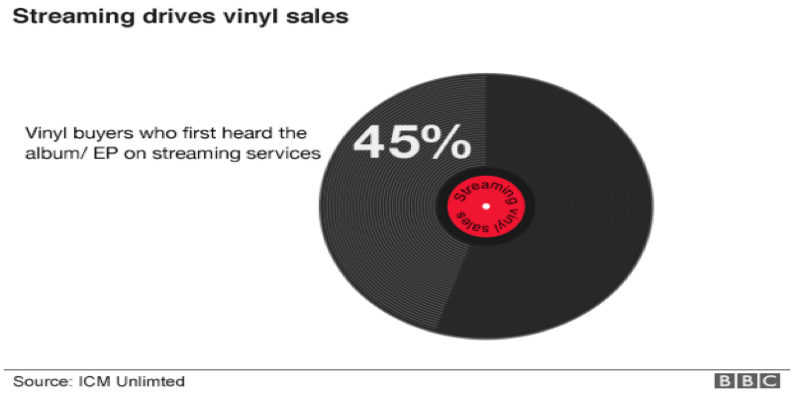
http://www.bbc.co.uk/news/entertainment-arts-36027867
According to an ICM poll, half of consumers tend to listen to an album online before purchasing a vinyl copy. This behaviour sees involved SoundCloud or YouTube users, highlighting that free music can generate a substantial profit.
For users the value of a service is the integration of their interactions and experience. Embracing the socio-cultural approach, we seek to learn what an individual does, feels, knows and says. Service Innovation involves changing practices, resulting in different experiences for users in which they change behaviours and perceptions. Also, think of the importance of serendipity as a mixture of observation and curiosity that allows us to learn from the unexpected: habits, stories, and meaning in the user experience. In the face of the consumer ‘weirdness’, Service Innovation can provide a holistic picture of what’s needed in designing a service experience.
How can we look at pains and gains for the usability issues?
I applied a Value Proposition Canvas split in two maps. Firstly, the Customer Profile clarifies your customer understanding. Secondly, the Value Map describes how you aim to create value for that customer. Finally, you achieve Fit between the two when one meets the other.
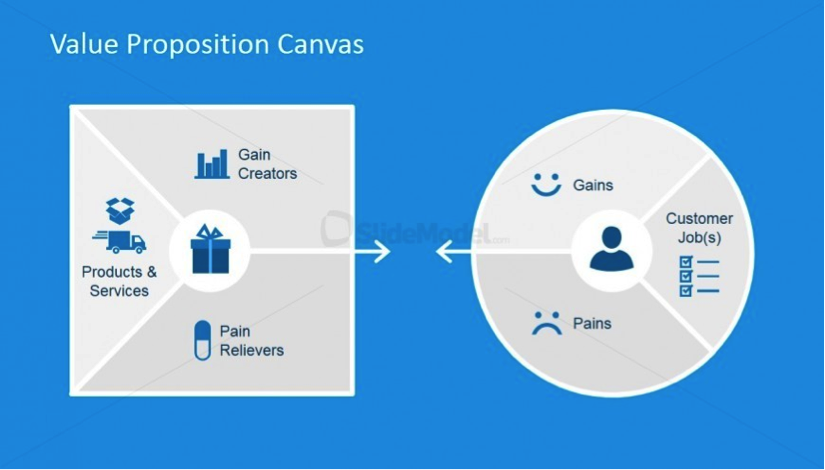
https://strategyzer.com/books/value-proposition-design
During the interviews, I used the Design Thinking toolkit in the discovery phase: observation, ethnography, empathy and listening. My aim was to unearth feelings and struggles in order to map extreme pains and essential gains.
Afterwards I started the Journey to step into the customer’s shoes:
 Customer Profile
Customer Profile
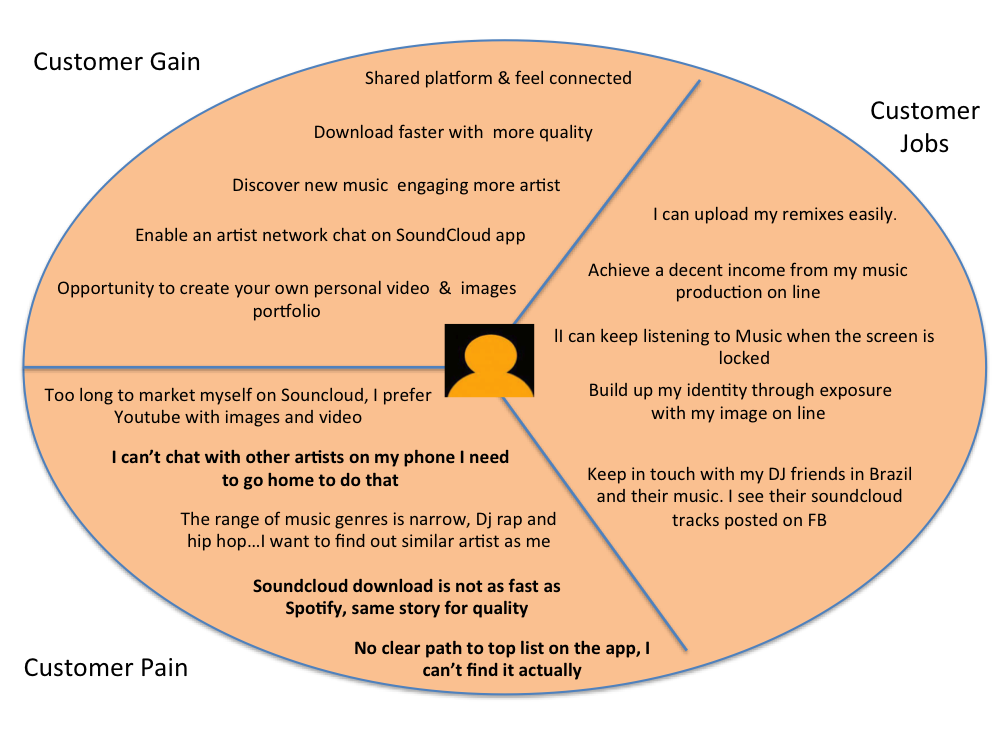
The Customer profile above depicts the discovery phase where I conducted interviews with five users. By listening and observing the users in their surroundings, my aim was to understand through open questions in three areas with empathy.
The customer jobs are how the users try to perform their tasks, the need they are trying to satisfy. The customer pains are anything that hinders the user before, during and after trying to get the job done. The customer gains are about how much the users would expect or dream a better performance as a desired gain.
I identified the following three SoundCloud usability issues according to what might leverage the users experience in the Android app:
1 – The barrier to communicate between users through messenger on the phone
2 – Lack of top sound quality along with a faster downloading
3 – No clear path to top lists on the app
Value Map
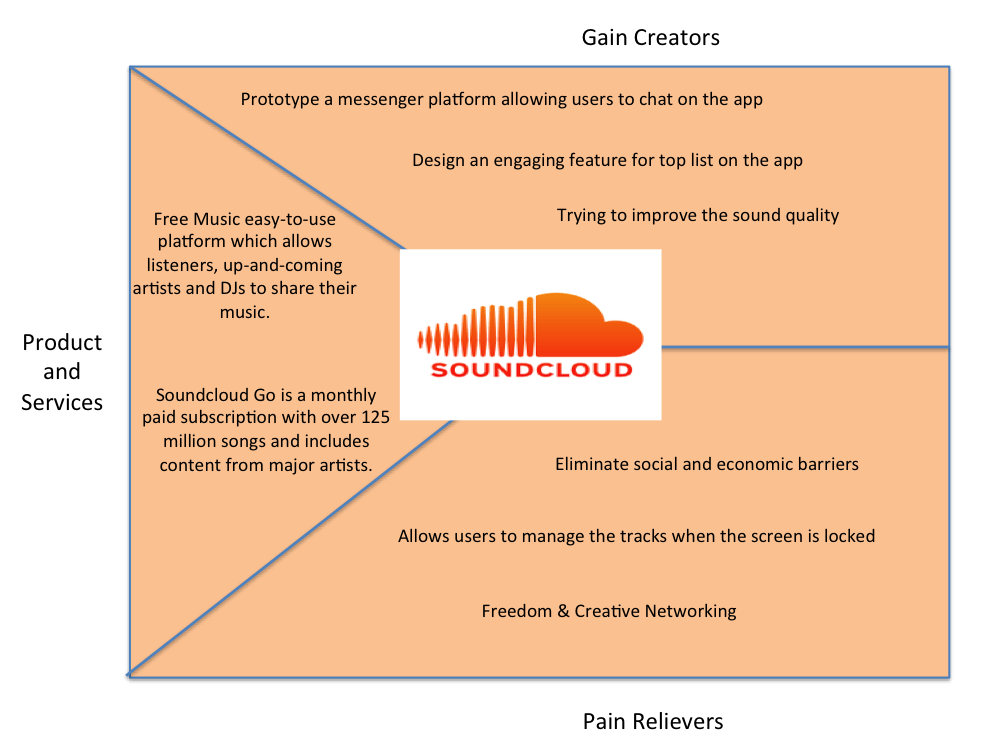
In the second map of the Value Proposition Design (above) I outlined what SoundCloud currently offers as Product and Services.
The Pain Relievers describe how SoundCloud alleviates specific customer pains, trying to remove obstacles that annoy the users before, during or after their tasks.
The Gain Creators are potential pathways to address the users’ expectations, desires or how including functional utility, social gains, and positive emotions would surprise them. Therefore, as result of this journey, in order to address the three usability issues identified, the three gains creators for the Android app would be:
1 – A messenger platform to allow users to chat to each other
2- A user friendly feature for a clear path to top lists
3 – Improvements in sound quality and downloading speed
Final Recommendations
The three identified issues require a further analysis. The following final recommendations are to expand my initial research for this complex business scenario and to complete the Value Proposition Design into Beta testing.
The first recommendation I suggest is to create the SoundCloud Brand Persona as result of motivations, attitudes, and behaviours among diverse users. Storytelling plays an important role to frame the challenge in human terms. A compelling story will bond the customers on an emotional level. The brand persona should serve as ‘Rosetta stone’ for the innovation process.
Secondly, it could be helpful to look at big data to try to apply a deep thinking on what really matters to the music users. Observe the users in the core of their activities to develop insights based on their known and unknown needs and wants. It is an approach that entails more watching than talking in order to understand where do they come from, how often, how long, where do they go, why. This is also known as PEST Analysis.
Finally, I recommend the Human-Centered Design approach (illustrated below) as a set of intuitive principles able to unlock potential solutions. Through a deep understanding of the user emotions, needs and feelings the Human-Centered Design approach shapes the value proposition design with prototyping possibilities. This methodology is an iterative process of investigating the users in their natural surroundings, turning barriers and obstacles into new opportunities.
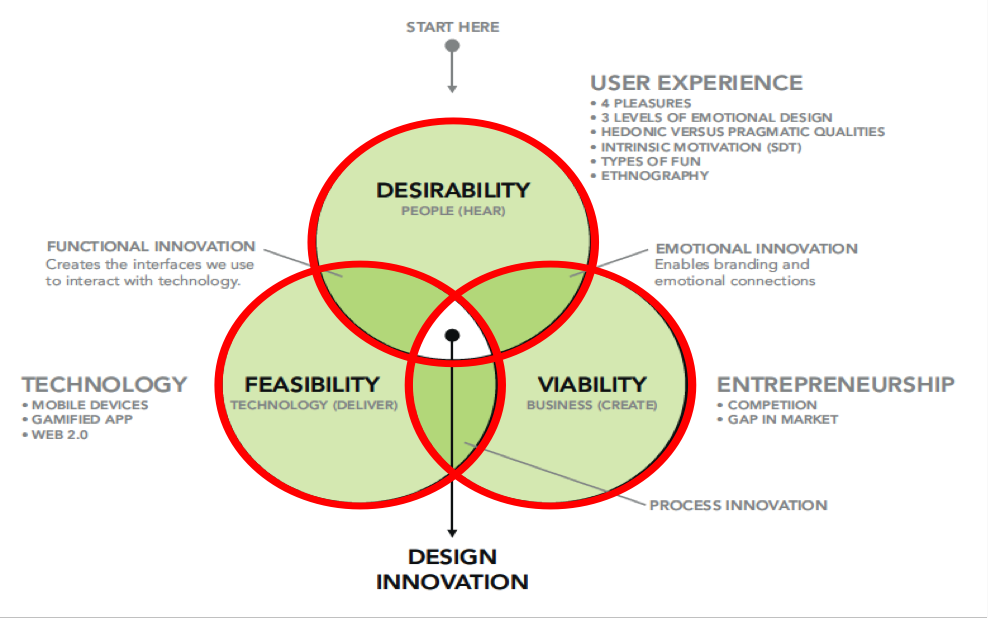 An intersection of hard data, customer centricity and human-centred design can provide a sustainable competitive advantage: eliminate customer pain, elevate customer service and create a personalized customer experience.
An intersection of hard data, customer centricity and human-centred design can provide a sustainable competitive advantage: eliminate customer pain, elevate customer service and create a personalized customer experience.
Posted on December 8, 2015
Example of agile culture ? Look at how Spotify works..
The concept of culture stems from the discipline of anthropology and sociology (Hatch, 1993). After the mid-1970s, an organisational sociologist realised there was a lack of understanding between organisational goals and actual outcomes. This gap raised interest in the concept of organisational culture. (Ouchi and Wilkins, 1985)
Amongst plenty of definitions, three dominant characteristics can describe the concept of organisational culture (Wilson, 1996). Firstly, culture is a shared phenomenon. Culture is seen as an array of social or normative dispositions that are shared by a given group and holds together diverse members (Schein, 1985). In a corporate scenario, the group might be the whole organisation or a subgroup. Secondly, culture expresses two levels: the surface level and the deeper level. The surface level comprises elements such as detectable patterns of behaviour shown by the group and physical artefacts, such as buildings. The deeper level of culture refers to the values that the group shares and the behavioural context set up by the members (Wiener, 1988). Thirdly, culture is learned. In an organisation scenario while a group assembles, culture often plays as the catalyst that gathers people in creating a sense of identity and belonging. (Dawson and Andriopoulos 2014)
Example of agile culture is at Spotify. It currently provides digital music streaming to 15 million paying users, and 60 million subscribers. Henrik Kniberg and Anders Ivarsson were in charge of the product development in the organisation in which at that time it counted over 30 teams across three cities in October 2012.
At Spotify the basic unit of development is the ‘squad’. It acts as a mini start-up applying principles such as MVP (Minimum Viable Product). It means releasing early and often. Each squad has skills and tools to design, develop, test and release to production. During the mission each squad develop expertise as they spend long time on the project.
To encourage learning and innovation the squad are allowed to spend almost 10% of their time on “hack days”. During this time people are free to experiment on whatever they want and share with their peers. A squad has a product owner, not a squad leader. They oversee the work priorities with no involvement in running the project.
Autonomy is one of the main values of this approach. A ‘tribe’ is an array of squads that work in linked areas. The tribe can be described as “the incubator” for the mini start-ups. Each tribe has a tribe lead who is charge for creating the best environment for the squads within the tribe. To avoid bureaucracy, politics and useless management practice the tribes’ capacity follows the “Dunbar number” concept. Most people cannot sustain a social relationship with more than 100 people or so. Therefore tribes are smaller than 100 people.
Scaling Agile @Spotify – Tribes
The two areas of development and operation are quite often related to dependency issues. At Spotify there is a separate operations team that supports the different squads and they play an important role throughout the production. Instead of creating a detailed process documentation they boost effective collaboration through face-to-face communication.
In a full autonomy culture, the drawback is a loss of economies of scale as Spotify essentially act as a bunch of small companies. ‘Chapters’ and ‘guilds’ show economies of scale as much as they keep the autonomy up.
The chapter is a cluster of people with complementary skills within the same expertise area, just like a tribe. The chapter lead is a line manager with the common responsibilities, such as developing people, setting salaries. He or she is also engaged with the squad to balance out the routine with ad-hoc projects.
A guild is a flexible organic “community of interest” where a group of peers share knowledge, ideas and tools. Chapters are always connected to a tribe whereas a guild moves across the organisation. An example is the coach of a guild. The coaches deliver knowledge consistently all over the organisation. They hold meetings to foster the organisation’s understanding and its improvement. These steps are carefully tracked on an improvement board.
Scaling Agile @Spotify – Tribe and Guild
Generally the matrix organisations see people gathered with certain skills into functional departments, they are “assigned” to projects, and “report to” a functional manager. Spotify are different – they focus on delivery.
Scaling Agile@ Spotify – Matrix
The vertical dimension in the matrix depicts how people are placed and where they spend their time. The horizontal dimension spurs the collaborative attitude. The chapter lead’s task is to nourish this flow of activities. The matrix structure guarantees that each squad member is guided to his or her own development.
The product owner is the “entrepreneur” focusing on delivering a product whereas the chapter leader is the “competency leader”, focusing on technical excellence. There is a motivating tension between these roles. The first tends to rush the process, the second wants to ponder the steps to reach a proper outcome. Both are necessary to build a “healthy” tension.
Scaling Agile @Spotify – Alignment

Posted on November 30, 2015
Ceo reputation is the rainbow of the future’s organization. And the leadership will benefit from it..
Weber Shandwick conducted a worldwide research published in 2015. The aim of the ‘CEO Reputation Premium: Gaining Advantage in the Engagement Era’ is to quantify CEO reputation and measure the importance of CEO engagement from those closest to the CEO.
As a result of the strong link between the CEO and company reputation and market value, according to the research, the reputation of the CEO is at a premium today, and is only going to grow more valuable.
Keeping a very low profile is not an affordable option in our progressively connected and transparent world. Despite the fact that there are high stakes that come with public visibility, taking the CEO out from behind the scene actually puts control of the CEO and company’s reputation in their own hands. In today’s highly unsteady world, CEO and company reputations are constantly shifting due to what is being said about them in the media, on social media, blogs and in unforeseen places by employees and customers.
Company Reputation – Top Six Drivers
Leadership can consistently enhance or affect creativity in the working environment (Mumford et al., 2002; Oldham and Cummings, 1996). The attitude of the leader could develop or inhibit employees’ creativity (Zhou and George, 2003). Some authors, such as Cummings and Oldham, agree that a ‘supportive’ supervisory management style is most likely to facilitate creativity than a ‘controlling’ one since it enhances individual motivation. A controlling approach is more likely to spur extrinsic motivation and hold the person from the flow of the creative process. Thacker’s (1997) empirical research emphasizes that group members should see the leader as a catalyst. The catalysts are the ones that make things happen, rapidly, that would not occur without them. Their striking ability is to handle situation skilfully in a world of uncertainties and resources’ constraints (Liedtka and Ogilvie, 2013).
How Executives Describe Their CEOs
CEOs have no choice but to value more of that informal conversation by explaining what their companies stand for and why it is important to hear what they have to say. Furthermore, CEOs have to be confident in their own skins when taking on this new mantle, but as a new generation takes the lead, public engagement with a greater purpose will only increase, and will become the new corporate imperative.
Posted on November 23, 2015
Storytelling is the landscape painter for change management
New service methods and sharing insights are rooted in storytelling methods. Compelling narratives outline the spine for all aspects of a company’s service, from the lives of its customers, to design employes experiences.
Transformational-change actions have a negative historical track record. In 1996, Harvard Business School professor John Kotter stated that nearly 70 percent of large-scale change programs did not meet their goals, and virtually every survey since has shown similar results. Why is change so confounding? The issue lies with the understanding of its building blocks—Kotter’s classic eight-step change-management model is still a helpful guide. The main challenge concerns who is responsible for launching the change process and how change is then implemented (McKinsey, 2014).
Davide Boje (2008) states that storytelling within organisations is about how to make people and the organisation sees the world through lenses of narrative and story. These stories are about dispersion of events in a wide frame of time – past to present – in order to design a feasible future.
‘Storying’ and ‘re-storying’ is an on-going process in this volatile world where people need to make sense and give sense to their lived experience. In the light of threatened identities, where conflict and resistance become prominent through ‘storying’ processes, clashing stories are on the spotlight during disputed change (Dawson and MacLean, 2013).
Innovation leader Claudia Kotchka helped to bring in Design Thinking at Procter & Gamble. For her, getting people involved to the methodology directly was a milestone. As she states, “Show, don’tell. The bottom line is, you just have to get as many people through it as you can. Because once someone experiences it, they are forever changed.” To achieve a cultural change Kotchka built design into the heart of P&G large organisation. (Kelly, T. 2013)
Firstly, Kotchka received the toughest problems from the P&G leaders. Then she set up an innovation fund to send a group of ‘conservative’ P&G executives to IDEO to work step by step with designers on some of the troublesome issues. Ultimately employees were trained as facilitators so they could conduct the workshops themselves. The workshop guided employees using brainstorming, researching end users, building prototypes, and enlarging upon concepts to a problem they were facing.
In seven years of Claudia Kotchka’s leadership, P&G built world-class capability. During the organisational change journey there are a few key areas.
Shared stories of confidence from who experienced the new innovation approach were proofs of its value. “Prototyping is both powerful innovation tool and powerful cultural value.” As Claudia explains: “In prototyping I have permission to be wrong and I want your feedback if it’s not working“. Which means ideas are no longer untouchables. If they were rejected, there were no bad feelings as if your idea had got killed.
We live in changes of era as much as we live in a world where we need to address the context more than the content. Ideas disjointed from the context in which they were generated often lose their resonance as they filter through an organisation. When placed within effective and accessible narratives, instead they are able to maintain their relevance, even when presented to people unfamiliar with how the project was conducted. Storytelling can help companies re-orientate their business and organisation around new service design principles.
Posted on November 17, 2015
Do the organisations disguise with Taylorism yet ? We need more Pixar-ism…
“to measure what you can, evaluate what you measure, and appreciate that you cannot measure the vast majority of what you do. At least every now and then, make time to take a step back and think about what you are doing.” Ed Catmull, Pixar Animations Studios
According to Lewis et al. (2011), Taylor’s impact on how to manage organisation’s life is assumed to be only historic interest. Frederick Taylor is considered as the architect of the concept of the organisation as a machine. His blueprint for on the efficient organisation seems to be still breathing as an unspoken and widely established axiom. Organisations currently deal with the desire to produce behaviour change without leading to an emotional reaction. This setback lies in relying on the emotional impact to perform motivation for change, in the same time to guarantee that no emotional impact happens. Change is perceived as a halt to the normal functioning of the organisation, because of its disruptive trait. Therefore if a problem arises the change is acknowledged as a ‘fixer‘. As a result, when innovation comes in, the organisations have to initially create an awareness of a problem. (Lewis et al., 2011)
Taylor’s legacy is still evident today looking at how efficiency is considered as an unquestioned organisational virtue. It downsizes other virtues, such as effectiveness. All the managerial practices such as job measurement, job evaluation and job equivalence are embodied in today’s organisations. Similarly, the emphasis on one best way of organising and on productivity is comprised in Management as control. Our understanding of organisations in change complies to see the leaders as the head and the organisation as the body. Again it flows from Taylor’s legacy that entails a variety of assumptions. Ultimately the assertions of a predictable and controllable change are still considered valid.
Considering the plethora of definitions, it is arguable whether culture can actually be managed and then changed. Scholars debate that culture lies at the core of organisational creativity and innovation. (Tushman and O’Reilly, 2002)
At Pixar Animation Studios one of the driving forces to strive for a creative culture has been a vital step called ‘postmortem‘. In the making of a movie the process’ phases, such as conception, protection, development planning and production, evolve over several years. After every movie has been released, before to move on, a ‘postmortem’ meeting was scheduled to explore what did and did not work. This aims to nurture and to share the lessons learned.
Companies as well as individuals do not seek for excellence by believing they are excellent, yet by understanding the ways in which they are not excellent. Since 1998 ‘postmortem’ has been used widely given the success of Pixar’s ‘A Bug‘s Life‘ movie. Even though the use of ‘postmortem’ has not been stable over time, there are good reasons to consider this tool to nurture the level of employee engagement.
If the process is flawed most likely you do not have the time to grasp it during the actual schedule. Thereafter sharing thoughts about it calmly consolidate the lesson learned. The ‘postmortem’ is a healthy way of passing on the message of positive or negative lessons to other peers who were not involved in the project. Therefore it is a forum to absorb or challenge the rationale beyond specific decisions. Quite often misunderstanding twists actions that become resentments, and if left overlooked it can negatively grow for years. The forum is a chance to address frustrations in a proactive manner, so then it empowers the employees to move on.
The time needed to arrange a ‘postmortem’ meeting is as valuable as the meeting itself. The approach to set up the meeting retains the value for a transparent discussion. Ultimately, during a ‘postmortem’, a questions session can be really helpful for the next project. No right answers are expected, but if other people can frame the right questions, then the horizon for a successful strategy might look positive.
Ed Catmull (2013) champions the idea that improving the ‘postmortem’ format could help the leaders:
change the format in order to avoid repeating the same lessons learned and soften the process asking everyone to make two lists: the top five things that they would do again and the top five things that they would not do again.
This balance will facilitate people to be candid. Creating and using data lowers the emotional involvement in discussing facts.
Considering the limits of data, a potential approach suggested by Ed Catmull is
“to measure what you can, evaluate what you measure, and appreciate that you cannot measure the vast majority of what you do. At least every now and then, make time to take a step back and think about what you are doing.”











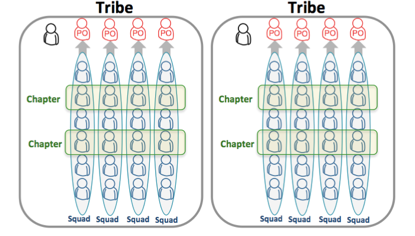



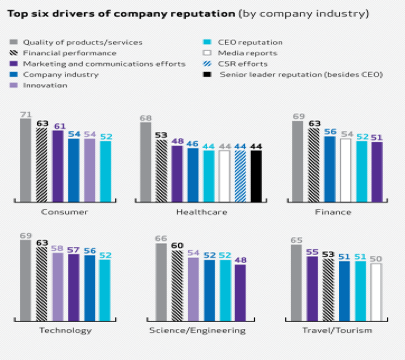
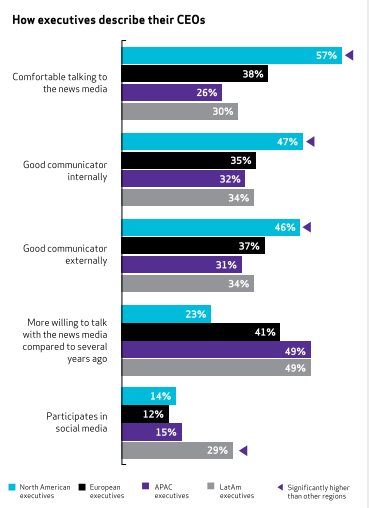



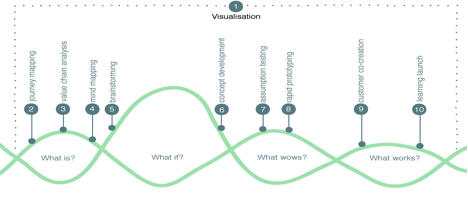
Recent Comments